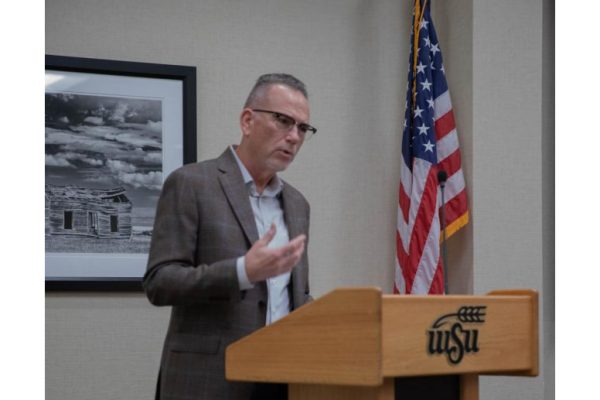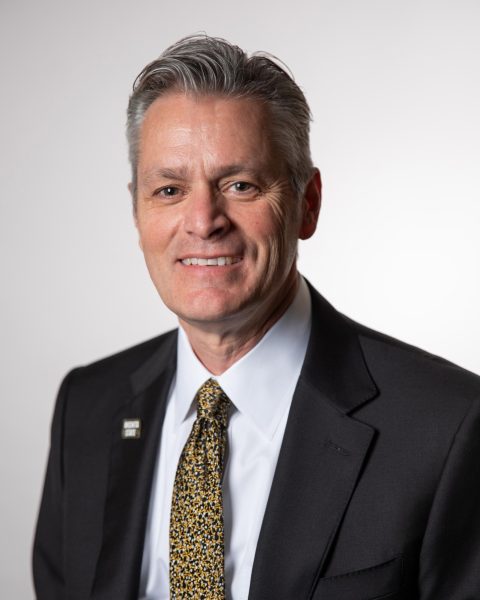Letter to the Editor — Rick Muma
The Sunflower published incorrect and misleading information in the article “Headcount Padding: Wichita State reports largest student increase in state,” on Monday, Oct. 2.
I’m responsible for leading the university’s enrollment efforts, and much of the misinformation could have been prevented had I been interviewed prior to the story being published.
The fact is, during the past two years, hundreds of students, faculty and staff have been involved in the university’s enrollment efforts. More than 40 students are currently employed in the Office of Undergraduate Admissions, and many more are associated with enrollment efforts in their colleges and academic departments.
To state that the university padded enrollment at the “last minute” is absolutely false and a disservice to the hundreds of university employees, including student workers, who have worked on our enrollment efforts. It implies that their work was somehow nefarious in nature and questions their integrity.
As the leader of WSU’s enrollment efforts and one who believes integrity is so important as a professional, it sickens me to think that somehow The Sunflower believed that we were leading the university down a path that lacked integrity.
I’d encourage everyone to revisit the university’s Strategic Enrollment Plan (SEM) – wichita.edu/semplan. In our efforts to be transparent, our plans for growing enrollment have been available on that website for the past two years. It utilizes best practices readily available in the higher education literature.
In that plan you’ll find the university’s enrollment goals, including Goal 5 to increase non-degree for-credit enrollment (badges, market-based tuition courses, etc.) by 14 percent annually through fall 2020. This goal is the main focus of The Sunflower article pointing out “last-minute enrollment of non-degree-seeking senior citizens, high school students and working professionals in half-credit-hour courses.”
The truth is the Faculty Senate approved a document to allow and encourage such offerings in 2015 – www.wichita.edu/j/?5917. There was nothing “last-minute” about this goal.
In order to reach the SEM plan enrollment goal of more than 18,000 students by 2020 (not counting WATC students), we will need to grow enrollment by about 5 percent annually in all areas, traditional, transfers, online and even non-degree bound students.
After surveying local employers and getting their input, we were confident that we’d see an increase in badge enrollment with the right mix of offerings. That’s why more than 30 new badges were developed by the colleges and approved by faculty during the last year in various subjects.
We started marketing and offering scholarship incentives for some of our badges in early August because most working professionals with families wait until school resumes before enrolling. Several of our employees have been involved in developing badges and travel the U.S. speaking at conferences about this innovative approach that opens up access to higher education.
Providing these types of opportunities, including the timing, are nothing new to WSU. For example, the previous administration annually provided hundreds of thousands of dollars of scholarships for students, which grew our high school concurrent enrollment. In the fall of 2011 the university provided full scholarships for 402 high school students and 906 the following spring. Those enrollments counted in past headcount totals.
In addition to enrollment increases in non-degree initiatives this fall, we have increases among first-time new freshmen (1,436, the most in university history for the second consecutive year) and minority students among all freshmen (24.2 percent).
We also saw continued growth in students majoring in online programs (32 percent increase) and continued growth in students living along the I-35 corridor (38 percent increase). All of these increases are a result of our SEM plan goal of growing enrollment to 18,000 students.
We intend to continue using the SEM plan to guide our enrollment efforts, and we will likely see increases in non-degree initiatives. We believe this is the wave of the future and a game-changer for higher education.
Rick Muma
Senior Associate Vice President for Academic Affairs and Strategic Enrollment Management












Rick Muma should be ashamed • Oct 10, 2017 at 6:13 pm
Rick Muma should be ashamed! Or he should run for president! This letter is so intellectually dishonest that it is even worse than padding the enrollment to begin with.
Muma’s argument is completely besides the point: “The fact is, during the past two years, hundreds of students, faculty and staff have been involved in the university’s enrollment efforts. More than 40 students are currently employed in the Office of Undergraduate Admissions, and many more are associated with enrollment efforts in their colleges and academic departments. To state that the university padded enrollment at the “last minute” is absolutely false and a disservice to the hundreds of university employees, including student workers, who have worked on our enrollment efforts. It implies that their work was somehow nefarious in nature and questions their integrity.”
These are irrelevant facts followed by false claims. It does not matter how many students or staff worked on admissions. The fact is that enrollment was padded through a bogus free sign-up period with the purpose of raising low “enrollment,” and that this was accompanied by a ridiculous attempt to promote the result as record high enrollment. That—the false promotion— is the action of a dishonest administration. And pointing it out does not do a disservice to any of the good, hard-working employees. The disservice is done by whoever commands this ridiculous propaganda, whoever is trying to distort and hide the truth at WSU. And, no, the story does not imply that any employees were “nefarious.” It does not even imply that the ones responsible for this decision were nefarious. That is the wrong word. It is dishonest and manipulative, not nefarious.
Having been called out, however, this response of Rick Muma—apparently on behalf of the whole university—is more dishonest than the original PR manipulation. This is where a yarn becomes a whopper. This is simply a load of BS, and everyone in the WSU community knows it.
On behalf of thousands of students and hundreds of faculty, I’d like to ask: What the hell is wrong with WSU’s administration?
Fake Pres. Bardo • Oct 9, 2017 at 1:28 pm
Students should know that at WSU I am king! I am the law of the land. If you disagree with me, I will label you as fake news and try to have you removed from campus. Dont you dare get in my way of getting a football team!
As always,
Fake Pres. Bardo
Yep • Oct 8, 2017 at 8:37 pm
I figured there would be silence from Rick Muma, Bardo, and “Fake News” Heldman since they got exposed by the Sunflower. Why not a follow up editorial to set us all straight on why the class was free right before census and not after and where the money came from to pay the application fees and tuition to make these “free”. Do you call those “scholarships”?
Waived Fees Fund Source • Oct 5, 2017 at 10:17 pm
Rick, since WSU can’t waive fees and tuition it had to be paid for from some source. What fund source paid the costs of waived application fees and “free” tuition?
Are Kansas taxpayers covering these costs through their state taxes? Do they really have to have their taxes go to pad enrollment through these special initiatives?
Rick, in keeping with Regent Chair Murfin’s (of MWCB) call for transparency I hope you or Bardo will be able to talk with the Sunflower and set us all straight on these things. Since you are so sickened about the thought of your professional integrity being challenged it would seem you will be willing to address all the questions and concerns that exist.
Just a reader • Oct 5, 2017 at 4:28 pm
This should be great news for all of the faculty whose salary Bardo tied to enrollment numbers….right?
I mean, they were going to get a 2% raise if enrollment increase a measly 3.5%
So throwing out numbers like 24%, 32% and 38% should be getting them about a 20% raise!!
Oh, it’s beginning to look alot like Christmas….
Raises • Oct 5, 2017 at 10:07 pm
Well, Ty Masterson got a 140% increase from $60,000 last year to $144,000 this year. He is a state senator who can also be a 1.0 FTE as the GoCreate Director.
Zach Gearhart, who is Andy Schlapp’s Assistant, got a 33% raise from $60,000 last year to $80,000 this year.
The salary book also shows that Tony Vizzini got a raise and Teri Hall got a raise and only worked there for six months.
Darron Boatright got a 4.1% raise from $192,000 to $200,000. This one is interesting given the last year.
Do these count as faculty salary raises?
Badges. We Don't Need No Stinking Badges • Oct 5, 2017 at 3:44 pm
Rick, the faculty senate link does not address the retirement home courses initiated a few days before census in Fall 2015. Can you list the 20-30 staff who were in that meeting and we can see if they remember the conversations? Bardo didn’t want the enrollment decrease to make him look bad.
So if I am at the Bel Aire Senior Center taking “Biblical Cities and Landscapes” on September 6, 13, 20, 1nd 27 for a couple hours each meeting, what is covered? How many credits? Can people still get in at Larksfield Place for “Wichita Looks at Rock and Roll”? even though the first class met Tuesday? What does that curriculum look like?
Aren’t these non-credit/lifelong learning classes at best?
Why is it not addressed why the enrolling for “free” ended September 15th?
Who did you work with in the high schools to get high school students enrolled in Badge classes? Here are a couple excerpts from the web page ad for Badges on September 1, 2017:
“Wichita State University is offering full scholarships for anyone wanting to enroll in one of 35 undergraduate online professional development badges. Badges are designed for working professionals who want to continue learning new skills and technologies to keep up with the needs of employers. The self-directed online courses allow students to go at their own pace each semester. Anyone who enrolls for one undergraduate-level badge now through Friday, Sept. 15, will have the full cost of the badge covered.”
and
““Once you’re fully immersed in work and everyday life, the thought of taking college classes can be daunting,” says Rick Muma, senior associate vice president for Academic Affairs and Strategic Enrollment Management. “The truth is, though, that to be continually competitive, professionals need the chance to grow in their field. Our badges fill that need while taking into account just how busy you really are.””
Ending the enrollment /credit “sale” on September 15th, right before census, is interesting. Rick, can you tell us why that was the deadline?
Regent Murphin has asked for transparency so I hope Rick will talk to the Sunflower and answer questions.
Eyes gloss over • Oct 5, 2017 at 2:37 pm
Correction: Rick…we all know you’re full of shit.
Eyes gloss over • Oct 5, 2017 at 2:32 pm
Rick…we all know your full of shit.
Fake Pres. Bardo • Oct 5, 2017 at 11:22 am
Bla Bla Bla.
don’t care about student employment
don’t care about scholarships
don’t care about the SEM plan
don’t care about employers interviewed
don’t care about scholarships
don’t care about online classes or I-whatever corridor
Did WSU skew their enrollment numbers to make things seem better than what they are?
Enrollment is up, total number of credit hours barley changed, and I believe this is a 4 year low point of total degree seeking students. Explain that
Also explain what is the likely hood of this freshman actually graduating? is it still only 19% in four years and 44% in 6 years.
As always,
Fake Pres. Bardo
Really • Oct 5, 2017 at 10:54 am
Rick, what happened to you?
This game started in the Fall 2015. After classes started, Bardo was mad because enrollment was down and this did not look good. So, he called a group of 30 or so people together and told them to get creative and find ways to increase enrollment. Thus was born the “Retirement Home Initiative” to create 4 day classes. These 30 people know who they are, why they were called together, and the consequence for not getting on board.
How is this not nefarious? What was the valuable academic purpose of these classes? It was designed to pad enrollment. Nothing more and nothing less. Louis Heldman can spin it however he wants. Pad enrollment.
After millions invested in consultants and a decline last year, a renewed push was on to get creative. Thus was born the “Badge Iniative”. Those are professional development classes. Nothing more and nothing less. Thank you Pat Bosco from Kansas State University for speaking the truth about academic integrity.
Rick is correct. There are many great people at WSU dedicated to serving students and working in an ethical manner. The current environment requires all the great people to compromise in many ways. Rick would certainly be one of them as he had to write this instead of the strategic communicators that handle the Innovation Campus spin.
Where is the faculty voice on the integrity of these classes? Does Faculty Senate endorse the academic value of a high school student being required to enroll in a 0.5 credit hour badge designed for working adults and professionals?
If these classes were not about padding enrollment, why weren’t they free before September 1st and after September 15th? How can you waive an application fee and tuition costs after classes start and end it right before census and not call it nefarious and enrollment padding? Just be honest.
Rick, don’t divert to the past practice of dual enrollment. Focus on the Retirement Home and Badge Initiatives that are the focus of discussion with enrollment padding this year.
People have to do certain things to keep their jobs. Nothing has been made more clear the past few years. If Rick knew what Bardo said about him in the past he might not be as excited to carry the water on this no-win topic. However, he is the latest person to be tasked with increasing enrollment so he does the best he can. At least he gets the WATC absorption bump next Fall.
Don’t blame the Sunflower for printing the story. Own the initiatives and be honest about how and when they came about and don’t blame the media.
It is about padding enrollment. Nothing more. Nothing less.
L • Oct 5, 2017 at 10:12 pm
Thank you for setting out these details.
In the words of Judge Judy “Don’t pee on my leg and tell me it’s raining”.
Steve • Oct 5, 2017 at 8:50 am
It makes me feel a whole lot better knowing that this false reporting and headcount padding was actually part of a strategic plan. This letter did not deny that it happened just tried to offer some lame justifications for it.